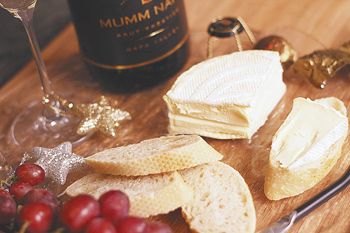A Toast to Triple Crème

By Christine Hyatt
December is perhaps the finest month to be a cheese lover. Cheese shops from coast to coast are brimming with the most bountiful selection from near and far. Wander into any reputable shop this time of year, and your options for ultimate cheese satisfaction are limitless.
Since last spring, cheesemakers have been preparing for the many end-of-the-year celebrations. Production is carefully calibrated to deliver an optimum amount of perfectly ripe cheese during the eight-week window between Halloween and New Year.
On the retail side, cheesemongers gaze into their crystal balls and roll the dice, preordering what they hope is the perfect amount — and variety — to meet holiday demand. If they are smart, they’ve ordered not just wheels but fancy crackers, tempting condiments and luxurious libations, too.
Champagne and other sparklers are pretty much synonymous with celebration; from the first ‘pop’ and fizz, the party is on. Lucky for us, Oregon makes fantastic bubbly — see page 20 — and lucky for me and other cheese lovers, bubbly partners perfectly with many cheeses.
One of the most heralded pairings in the cheese world is that of French Champagne and a decadent triple crème. Indeed, the two grew up as neighbors. Triple crèmes, which postdate Champagne’s world-famous bubblies by more than a century, originated in the area around Paris while the Champagne region lies just over 93 miles east.
Small, ripened cheeses enriched with cream were introduced in the late 19th century; then they disappeared during the deprivations of World War I.
In the 1930s, triple crème returned — Parisian fromager Henri Androuët named the cheese Brillat-Savarin in honor of the French gastronome — only to fade again during World War II. It was reintroduced in the 1950s by tastemaker Henri Boursault, a cheese producer outside Paris. During the war, no fat was added to cheese. Boursault brought the fat back, believing consumers were ready for a decadent, buttery style, which no one was making at the time.
In 1953, he introduced his eponymous triple crème, Boursault, known for its thin white rind and lavish, butter-like texture. It was an immediate sensation. Brillat-Savarin was reintroduced, and other imitators soon followed.
One of the most famous is Explorateur, invented in 1958 and named after the U.S. rocket Explorer 1, the first earth satellite that launched the same year. To this day, the label sports a stylized rocket on a glossy gold label.
Whether it’s the original or well-done reproduction, all quality triple crèmes are rich and buttery. The flavor is mellow and mushroomy with sweet cream notes and an unctuous texture.
Once the cheese is cut, you may notice an interior ‘heart’ which is firmer, denser and whiter than surrounding paste just beneath the rind. This is the aging process at work. Penicillium cultures in the rind ripen inward. Like fruit, ripened cheese softens as it matures.
I suggest trying the rich interior first to appreciate the subtle sweetness and textural differences between the heart and the softer, more assertively flavored paste beneath the rind.
To eat or not eat the rind is a perennial debate among cheese lovers. I recommend trying it after exploring the nuances of the paste. Depending on the producer and age of the cheese, some rinds can exhibit a distinctly medicinal aftertaste, which is why many people, including me, discretely cut away the rind from a wedge on my plate.
Note: While newly unwrapped cheeses may exhibit a hint of ammonia on the nose, the aroma should dissipate within a few minutes of opening. If the flavor is pervasive, it is a sign of overripe or mishandled cheese.
Not all rinds are alike; and some are quite delicious. Astringent notes in some may even complement a glass of sparkling wine. And on the flipside, sparkling’s effervescence — let’s call them ‘scrubbing bubbles’ — cleanses the palate, preparing your mouth for the next bite of cheese.
When it comes to finding a triple crème to pair with sparkling, the French selections mentioned above will not disappoint, include St. André but some American options are out there as well.
Try Seastack by Mt. Townsend Creamery, Kunik from Nettle Meadow and Marin French Cheese Company’s Triple. Any way you slice it, you can’t go wrong.
Until next year — OK, really next month — a toast to triple crème and bubbles and have a wonderful holiday season.
Christine Hyatt is a passionate ‘cheese creative,’ celebrating cultured curd through the written word, photographs and educational videos. Connect with her on Facebook and Twitter @cheesechick1








